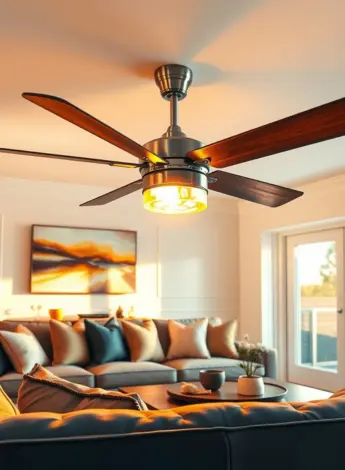
Introduciton
Ceiling fans are an excellent addition to any home, providing both comfort and energy efficiency. Among the many brands available, Harbor Breeze stands out as a trusted name, known for stylish designs, durability, and affordable pricing. Whether you’re a first-time buyer or looking to upgrade an older fan, this comprehensive guide will help you understand Harbor Breeze ceiling fan models, parts, and essential tips for maintenance and repairs. We’ll also discuss how and where to purchase Harbor Breeze replacement parts to keep your fan running like new.
Overview of Harbor Breeze Ceiling Fan Models
Harbor Breeze offers a wide range of ceiling fans designed for different room sizes, decors, and installation needs. Here are some of the most popular types of models:
1. Flush Mount (Hugger) Ceiling Fans
Ideal for rooms with low ceilings, these fans mount directly to the ceiling without a downrod. Models like the Harbor Breeze Armitage or Harbor Breeze Classic are common in bedrooms and small living areas.
2. Downrod Ceiling Fans
These fans are designed for rooms with standard or high ceilings. They come with a downrod that lowers the fan from the ceiling to optimize airflow. Fans such as the Harbor Breeze Mazon and Harbor Breeze Saratoga fall into this category.
3. Outdoor Ceiling Fans
Made with weather-resistant materials, outdoor models like the Harbor Breeze Twin Breeze are perfect for patios, porches, and gazebos. These fans are rated for damp or wet locations, depending on the design.
4. Smart and Remote-Controlled Fans
Some Harbor Breeze fans include built-in remote controls or can be paired with smart home systems. Models like the Harbor Breeze Sail Stream offer convenient operation with minimal effort.
Key Features to Consider
When choosing a Harbor Breeze fan, consider the following features:
- Blade span: Determines the area the fan can cover. A 52-inch fan is suitable for most standard rooms.
- Number of blades: More blades often mean quieter operation but may circulate air less aggressively.
- Lighting: Many fans come with integrated lights or light kits. LED lighting is energy-efficient and long-lasting.
- Motor quality: Look for fans with reversible motors, which allow for year-round use—counterclockwise in summer, clockwise in winter.
Essential Parts of a Harbor Breeze Fan
To better understand your ceiling fan and how to maintain it, it’s helpful to know its key components:
- Fan Blades: Move air and are available in various materials and finishes.
- Motor Housing: Contains the motor that powers the fan.
- Downrod (if applicable): Connects the fan to the ceiling mount.
- Mounting Bracket: Secures the fan to the ceiling.
- Light Kit: Optional feature that provides integrated lighting.
- Remote Control or Wall Control: Operates fan speed and lighting.
- Pull Chains: Manual control method for some models.
Harbor Breeze Replacement Parts: What You Need to Know
Over time, parts of your fan may wear out or break. Fortunately, Harbor Breeze makes it relatively easy to find replacement parts to restore functionality without replacing the entire unit.
Common Replacement Parts Include:
- Fan Blades: Cracked or warped blades can be replaced individually.
- Remote Controls and Receivers: Often lost or malfunctioning over time.
- Light Kits and Bulb Covers: For upgrading or replacing broken fixtures.
- Capacitors and Switches: Help restore fan speed and motor functionality.
- Mounting Brackets and Downrods: Needed when re-installing in a different room or repairing damage.
Where to Purchase Harbor Breeze Replacement Parts
- Lowe’s: As the exclusive retailer of Harbor Breeze fans, Lowe’s is the primary source for genuine parts.
- Harbor Breeze Customer Support: Contact the manufacturer with your fan’s model number for direct replacements.
- Online Marketplaces: Websites like Amazon or eBay may carry older or hard-to-find parts, though compatibility must be verified.
Tip: Always use the model number of your fan (usually found on the motor housing or in the user manual) when searching for replacement parts to ensure proper fit and function.
Installation and Maintenance Tips
Installation Tips:
- Turn off the power at the circuit breaker before installation.
- Use a fan-rated electrical box to support the weight of the fan.
- Follow the instruction manual provided with your fan for step-by-step guidance.
- If unsure, hire a licensed electrician to ensure safe installation.
Maintenance Tips:
- Dust fan blades regularly to maintain air quality and prevent motor strain.
- Check and tighten screws on blades and housing to prevent wobbling.
- Replace worn parts promptly to prevent larger issues.
- Balance the fan if it starts to wobble—balance kits are often included or can be purchased.
Troubleshooting Common Issues
Here are a few common problems and solutions:
- Fan not turning on: Check wiring, breaker, or remote control batteries.
- Wobbling fan: Inspect for loose screws, uneven blades, or mounting issues.
- Noisy operation: Ensure all screws are tight and the fan is balanced.
- Lights not working: Replace bulbs or check connections in the light kit.
Final Thoughts
Harbor Breeze ceiling fans are a smart investment for homeowners looking to improve comfort and airflow in their spaces. With a wide range of styles, sizes, and features, there’s a fan for virtually every room and setting. Understanding the different models, essential parts, and how to care for your fan will help you make the most of your purchase.
When repairs or upgrades are needed, buying genuine Harbor Breeze replacement parts ensures compatibility and extends the life of your fan. Whether you’re a DIY enthusiast or just looking for a reliable ceiling fan, Harbor Breeze offers the perfect blend of value, performance, and style.